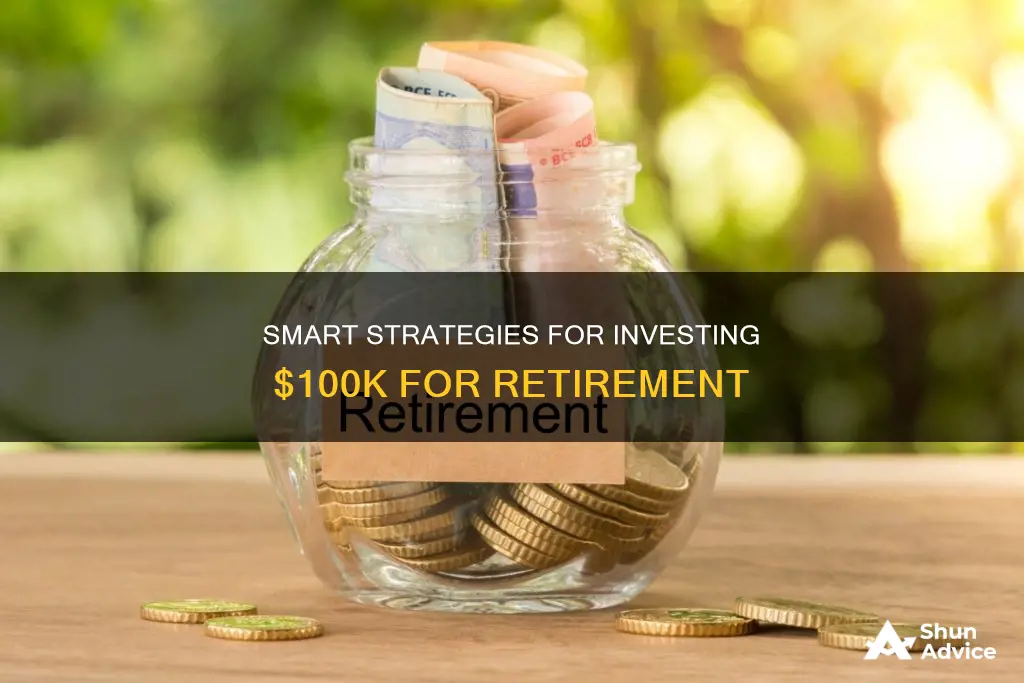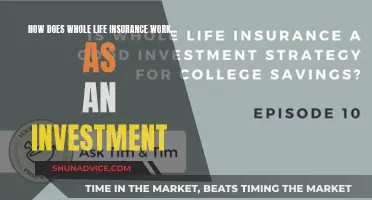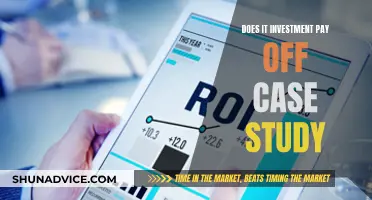
Investing $100,000 can be a great way to start building long-term wealth. However, before you start investing, it's important to ensure that you have no high-interest debt, an adequate emergency fund, and enough money to easily cover your monthly expenses. Once you've ticked these boxes, there are several ways to invest your money, each with its own level of risk and potential reward.
One option is to invest in the stock market, focusing on growth industries and stocks, such as cloud computing, e-commerce, financial technology, and healthcare. You can also invest in dividend-paying stocks, which offer a stable source of passive income. Another option is to invest in exchange-traded funds (ETFs) and mutual funds, which provide instant diversification across various industries.
If you're looking for a more hands-off approach, you can consider investing in bonds, which generally fluctuate less than stocks and are well-suited for short-term investing. Real estate is another popular investment option, whether through purchasing property directly or investing in real estate investment trusts (REITs).
Before deciding how to invest your $100,000, it's crucial to understand your financial goals, risk tolerance, and investment time horizon. It's also important to remember that investing involves risk, and there is always the potential to lose money as well as gain it.
| Characteristics | Values |
|---|---|
| Priority before investing | Pay off high-interest debt, set up an emergency fund, pay off credit card debt |
| Investment options | Individual stocks, real estate, retirement accounts, ETFs, mutual funds, bonds, robo-advisors, peer-to-peer lending, REITs, dividend stocks, education, business |
| Considerations | Risk tolerance, financial goals, time horizon, fees, taxes, diversification, investment advisor |
What You'll Learn

Invest in stocks
If you have $100,000 to invest in stocks, there are several things to consider.
Firstly, it is important to note that investing in stocks is risky, and you should only do so if you have already paid off any high-interest debt and have an emergency fund in place.
If you are new to investing, it is recommended that you do some research before diving in. You should also consider seeking advice from a licensed financial advisor, who can help you understand your risk tolerance and create a plan that aligns with your financial goals.
When investing in stocks, diversification is key. It is generally recommended that you invest in at least 15-20 different stocks from varying industries to minimise your risk. This strategy is known as dollar-cost averaging.
One way to achieve diversification is to invest in exchange-traded funds (ETFs) or mutual funds. These are baskets of pre-bundled stocks that provide instant diversification. ETFs are passively managed and often track a specific index, such as the S&P 500. Mutual funds, on the other hand, are actively managed by fund managers and may provide better returns. However, they also tend to have higher fees.
When choosing individual stocks to invest in, it is important to assess the risk. Buying blue-chip stocks may provide the biggest rewards, but it is also one of the riskiest strategies. It is recommended that you limit the portion of your portfolio devoted to high-risk stocks to a minority of your holdings.
Some specific stocks that have been recommended by experts include Microsoft, Nike, Visa, and Warren Buffett's Berkshire Hathaway. The tech giants Facebook, Apple, Amazon, Netflix, and Google's parent company Alphabet are also considered solid options.
Another strategy to consider is investing in dividend stocks, which provide a stable source of passive income. The best dividend-paying companies are those that steadily increase their dividends over time, as this usually indicates that the company is growing.
Finally, remember to always invest with a long-term perspective and avoid making impulsive decisions based on short-term market fluctuations.
Investments: What's Hot Right Now
You may want to see also

Invest in real estate
Investing in real estate is a great way to diversify your portfolio and manage risk. Here are some ways you can invest $100,000 in real estate:
Active vs. Passive Investing
Active real estate investors scout out deals, manage properties, and deal with vendors and tenants. This approach can be time-consuming and challenging but can be a good way to learn the business. Passive investors, on the other hand, purchase income-producing real estate and hire experienced professionals to handle day-to-day operations. This approach is more hands-off, generates potentially higher returns, and is more cost-effective.
Single-Family Rental Homes
Investing in single-family rental homes is a good option if you want a long-term investment. With a $100,000 investment, you may be able to purchase a home worth approximately $333,000, assuming a 30% down payment. However, if you choose to manage the property yourself, be prepared to deal with repairs, rent collection, and difficult tenants. Alternatively, you can hire a property manager, which will reduce your net income but also the hassles.
House Flipping
House flipping involves purchasing a single-family home in need of repair, renovating it, and then selling it for a profit. The key to success is finding a motivated seller and accurately estimating the cost of renovations and the realistic selling price.
Commercial Property
Commercial properties, such as apartment complexes, office buildings, warehouses, and shopping centers, can generate steady rental income. However, they tend to be more expensive than single-family homes. If you have limited funds, you can consider joining other investors to acquire commercial properties through joint ventures.
Real Estate Investment Trusts (REITs)
REITs are publicly traded companies that invest in real estate and distribute income from rent or property sales to shareholders. They offer high levels of diversification, and investing in them is as easy as buying shares of any public company. REITs must pay out at least 90% of their profits, making them a great way to get exposure to commercial properties without a large capital investment.
Mutual Funds and ETFs
Real estate-focused mutual funds and exchange-traded funds (ETFs) invest primarily in REITs and real estate operating companies. They are highly diversified and cost-effective, and shares can be bought and sold online easily.
Crowdfunding
Crowdfunding involves pooling funds with other investors, often through an online platform, to purchase specific properties. Investors receive benefits such as cash flow from rent or gains from the sale of the property, proportional to their investment. Some real estate crowdfunding platforms have minimum investments as low as $500, making it an accessible option for smaller investors.
Tesla: The Future of Electric Cars
You may want to see also

Pay off debt
Paying off debt is a crucial step in achieving financial freedom and a comfortable retirement. Here are some detailed instructions and considerations to help you effectively utilise your $100K for this purpose:
Evaluate Your Debts
The first step is to gain a comprehensive understanding of your debts. List all your debts, including college loans, car payments, credit cards, and mortgages. Note the balances, minimum monthly payments, and, most importantly, the interest rates associated with each debt. Focus on debts with high-interest rates, such as credit cards, as these can be detrimental to your financial health.
Prioritise High-Interest Debt
The interest you pay on credit card debt is usually significantly higher than the returns you can expect from most investments. For example, if you have a credit card with a 17% interest rate, paying it off will give you a guaranteed 17% return on your money, which is difficult to achieve through investing alone.
Understand the Impact of Debt on Your Investments
Even if you have relatively low-interest debt, it can still hinder your investment capabilities. For instance, if you expect to earn 5-10% annually in the stock market over ten years, paying off a 15% interest loan will provide a better return and reduce the risk of forced investment sales.
Create a Debt Repayment Plan
Once you've addressed high-interest debt, develop a strategy for managing your lower-interest debt. The "debt snowball" method is a popular approach. This involves listing your debts from smallest to largest and focusing on paying off the smallest debt first. As each small debt is eliminated, you gain a sense of accomplishment and momentum, gradually building towards tackling larger debts.
Consider the Snowball Method's Psychological Benefits
The snowball method not only helps you reduce debt but also provides psychological benefits. By quickly eliminating smaller debts, you'll feel a sense of progress and motivation. This can be especially helpful if you're someone who values the immediate gratification of seeing your debts disappear one by one.
Weigh the Benefits of Investing vs. Debt Repayment
While paying off debt is generally advisable, investing simultaneously shouldn't be entirely neglected. Assess your financial situation and emotional relationship with money. If investing for retirement is a priority, ensure you're contributing enough to capture any employer-matching arrangements, such as a 401(k) match. This can provide a significant return and is often prioritised over non-mandatory debt repayment.
Build an Emergency Fund
Another crucial aspect is preparing for unexpected expenses. Establish an emergency fund containing three to six months' worth of living expenses in a high-interest savings account. This will ensure that you don't have to rely on expensive credit cards or loans in case of emergencies, helping you avoid accumulating more debt.
Maximise Your Retirement Contributions
Once you've addressed your debt and built an emergency fund, focus on maximising your retirement contributions. Contribute more than the minimum to take full advantage of any employer-matching programmes. If you're already debt-free and have sufficient emergency funds, investing a significant portion of your $100K in retirement accounts can be a wise decision.
In summary, paying off debt is a crucial step towards achieving financial freedom and a comfortable retirement. By following the steps outlined above, you can effectively utilise your $100K to reduce debt, improve your financial stability, and set yourself up for a secure future.
Retirement Investing: Why You Shouldn't Bother
You may want to see also

Set up an emergency fund
Setting up an emergency fund is an essential step in protecting yourself financially and is one of the first steps you can take towards saving for retirement. An emergency fund is a cash reserve set aside for unplanned expenses or financial emergencies, such as car repairs, home repairs, medical bills, or a loss of income.
The amount you need for your emergency fund depends on your situation. A common recommendation is to save three to six months' worth of expenses. However, this may vary depending on factors such as the number of dependents you have, whether your spouse is employed, or whether you have wealthy parents who can help you out. If you have one income, are self-employed, and have a family to support, you may want up to eight months' worth of savings in your emergency fund.
- Create a savings habit: Set a specific goal for your emergency fund and create a system for making consistent contributions. Regularly monitor your progress and celebrate your successes.
- Manage your cash flow: Keep track of when your money is coming in (your income) and going out (your expenses and spending). This will help you identify opportunities to adjust your spending and savings.
- Take advantage of one-time opportunities to save: If you receive a large sum of money, such as a tax refund or a cash gift, consider saving all or a portion of it to quickly build your emergency fund.
- Make your saving automatic: Set up recurring transfers from your checking account to your savings account. This will help you save consistently without having to remember to transfer funds manually.
- Save through work: If you receive your paycheck through direct deposit, check with your employer if it's possible to divide it between your checking and savings accounts.
When deciding where to keep your emergency fund, look for a safe, accessible place that is separate from your day-to-day cash to ensure it's there when you need it. Options include a dedicated bank or credit union account, a prepaid card, or keeping cash on hand in your home or with a trusted family member or friend.
Strategic Retirement: Navigating the Best Investment Options for Your $450,000
You may want to see also

Invest in retirement accounts
Retirement accounts are a great way to invest $100,000. This is especially true if you have already paid off any high-interest debt and have an emergency fund in place.
There are two main types of retirement accounts: those offered by your employer, such as a 401(k) or 403(b) plan, and those that you set up yourself, such as an IRA. Both types offer tax advantages, although the rules differ slightly between them.
With a 401(k) or 403(b) plan, you contribute through automatic payroll withholding, and your employer may also add money through matching contributions. For example, your employer might contribute a certain percentage of your salary if you put in that amount. Contributions to these plans are typically made with pre-tax income, so you pay income taxes when you withdraw the money in retirement. This is beneficial if you expect to be in a lower income tax bracket when you retire.
With an IRA, you can choose between a traditional IRA and a Roth IRA. A traditional IRA is tax-deductible, meaning you can deduct your contributions from your taxable income. However, you will have to pay taxes on withdrawals when you retire. On the other hand, contributions to a Roth IRA are made with after-tax funds, but you can make withdrawals tax-free in retirement. Additionally, Roth IRAs do not require minimum distributions during the owner's lifetime.
There are income and contribution limits for both types of IRAs, and these limits differ depending on factors such as your age and filing status. For example, for 2023, the contribution limit for a traditional or Roth IRA is $6,500, plus an additional $1,000 if you are age 50 or older.
When deciding where to invest your $100,000, it is important to consider your financial goals, risk tolerance, and time horizon. It may be helpful to consult a financial advisor to determine the best investment strategy for your specific situation.
Monthly Retirement Planning: Investing $1000 for a Secure Future
You may want to see also
Frequently asked questions
The best ways to invest 100k for retirement include investing in individual stocks, buying ETFs or mutual funds, real estate, retirement accounts, and peer-to-peer lending.
Investing in individual stocks offers some of the best diversification for your portfolio, allowing exposure to nearly every industry and historically providing one of the best returns on investment.
ETFs (exchange-traded funds) and mutual funds are baskets of stocks that provide instant diversification. ETFs are often index funds that track a specific index and are passively managed, while mutual funds are actively managed by fund managers and may have better returns.
You can invest in traditional real estate by purchasing and renting out properties, or consider alternatives such as REITs (Real Estate Investment Trusts), which are portfolios of properties that generate income and can be purchased for a relatively low cost.
Before investing, ensure you have paid off high-interest debt and established an emergency fund. Determine your investment goals, risk tolerance, and whether you want to be actively involved in managing your investments. Diversify your portfolio and consider tax-advantaged retirement accounts to minimize taxes and fees.







